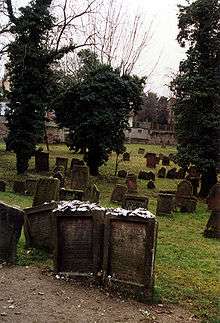Meir of Rothenburg
| Meir of Rothenburg | |
|---|---|
 Tombs of Meir of Rothenburg (left) and Alexander ben Salomon Wimpfen (right) in the Jewish cemetery of Worms | |
| Personal details | |
| Born |
c. 1215 Worms, Holy Roman Empire |
| Died |
1293 Wasserburg am Inn, Bavaria |
Meir of Rothenburg (c. 1215–1293)[1] was a German Rabbi and poet, a major author of the tosafot on Rashi's commentary on the Talmud. He is also known as Meir ben Baruch, the Maharam of Rothenburg. Rabbi Menachem Meiri referred to Rab Meir of Rothenberg, as the "greatest Jewish leader of Zarfat" alive at the time, Zarfat is Medieval Hebrew for France which was a reference to Charlemagne's rule of Germany.
Biography
Rabbi Meir was born between 1215 and 1220 in Worms. He comes from a long line of rabbis. His first teacher was his father. He continued his training in Würzburg under Isaac ben Moses of Vienna and in France, where he remained until 1242, his teachers being Yechiel of Paris, Samuel ben Solomon of Falaise, and Samuel of Évreux, witnessing the burning of the Talmud on June 17, 1244, in Paris. He then settled in Rothenburg ob der Tauber, opening a yeshiva in his house. After the death of his father in 1281, he settled in Worms. In 1286, King Rudolf I instituted a new persecution of the Jews, declaring them servi camerae ("serfs of the treasury"), which had the effect of negating their political freedoms. Along with many others, Meir left Germany with family and followers, but was captured in the mountains of Lombardy having been recognized by a baptized Jew named Kneppe, and imprisoned in a fortress near Ensisheim in Alsace. Tradition has it that a large ransom of 23,000 marks silver was raised for him (by the Rosh), but Rabbi Meir refused it, for fear of encouraging the imprisonment of other rabbis. He ruled on his own abduction in light of Talmudic law.[2] He died in prison after seven years. Fourteen years after his death a ransom was paid for his body by Alexander ben Salomon Wimpfen, who was subsequently laid to rest beside the Maharam in the Jewish cemetery of Worms.[3]
According to Rabbi Chaim Joseph David Azulai's Shem HaGedolim,[4] a disciple of Rabbi Meir of Rothenburg, whose name was Rabbi Meir HaCohen, wrote the famous commentary on Maimonides' Mishneh Torah, entitled Hagahot Maimoniyot.
Works
Rabbi Meir wrote no single major work, but many notes, commentaries, expositions, and poems—as well as 1,500 responsa. His disciple the Rosh (Rabbi Asher ben Jehiel) codified much of his teaching.
- His responsa are of great importance to advanced students of the Talmud, as well as to students of Jewish life and customs of those days, especially for the picture which they give of the condition of the German Jews, and of their sufferings from the caprice of princes and from heavy taxation. These responsa also contain rulings of other older and contemporary Ashkenazi poskim; see History of Responsa: Thirteenth century.
- Rabbi Meir is well known as a Tosafist and in particular, authored the Tosafot commentary of the Talmudic tractate Yoma; he is quoted in the Tosafot on various other tractates. He also authored commentaries on the Tohorot and Zeraim orders of the Mishnah.
- Rabbi Meir wrote a number of liturgical poems ("piyyutim").
- His writings on specific areas of Halakha (Jewish Law) include:
References
- ↑ Gedaliah ibn Jechia the Spaniard, Shalshelet Ha-Kabbalah, Jerusalem 1962, p. 134 (Hebrew)
- ↑ McManus, Shani (July 13, 2015). "Responding to terror explored". South Florida Sun-Sentinel.
The Jewish people have experienced similar situations throughout our arduous history," Rabbi Zalman Abraham of JLI headquarters in New York noted. "When Rabbi Meir of Rothenberg was imprisoned for ransom in the Middle Ages, he ruled on his own abduction in light of Talmudic law."
- ↑ http://www.chabad.org/calendar/view/day.asp?id=265714&tDate=3/4/2006#265714
- ↑ Chaim Joseph David Azulai, Shem HaGedolim (vol. 2), Livorno 1786, s.v. הגהות מימוניות (Hebrew)
External links
- Meïr of Rothenburg (Meïr B. Baruch), jewishencyclopedia.com
- Maharam of Rothenburg (circa 4980 - 5053), chabad.org
- Works of the Maharam during his imprisonment (Hebrew), daat.ac.il
- "Maharam of Rothenburg: The Perils of Jewish Leadership," Video Lecture by Dr. Henry Abramson